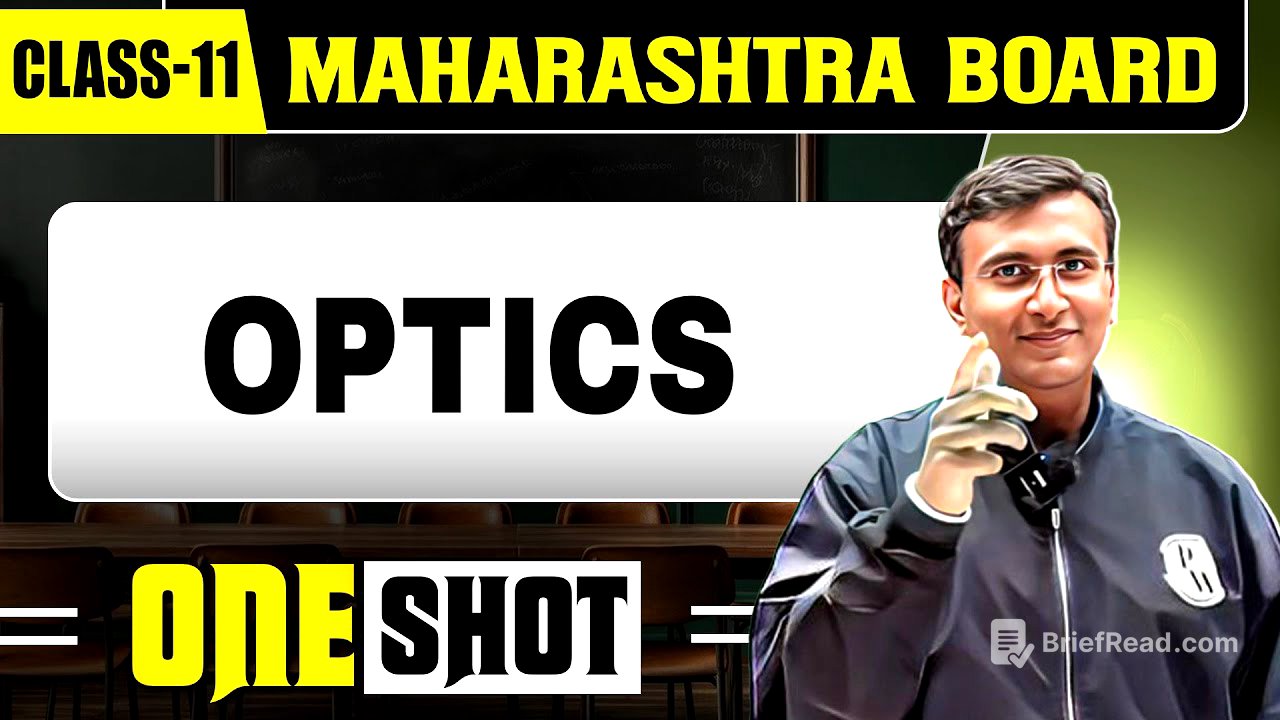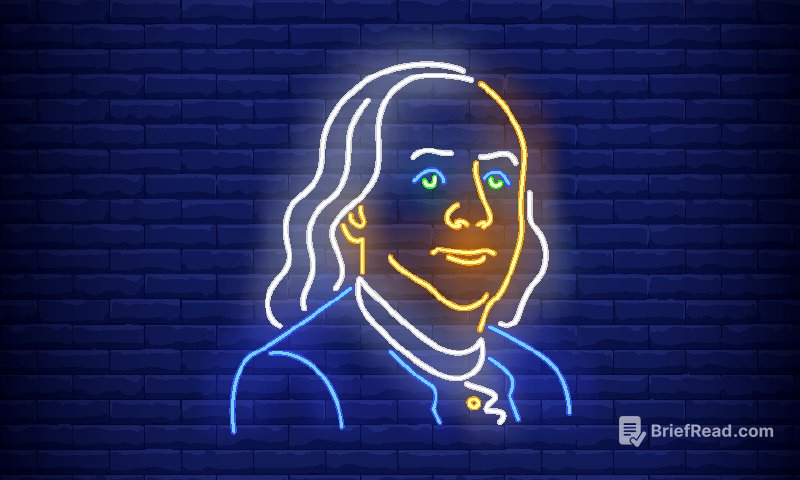TLDR;
This video provides a comprehensive overview of optics, starting with reflection and refraction, then moving into lenses, prisms, and optical instruments like microscopes and telescopes. It covers key concepts such as laws of reflection and refraction, image formation by mirrors and lenses, total internal reflection, and dispersion. The lecture includes definitions, derivations, and problem-solving, aiming to clarify complex topics for students preparing for exams.
- Covers reflection and refraction laws and phenomena.
- Explains image formation in mirrors and lenses.
- Discusses optical instruments like microscopes and telescopes.
- Includes derivations and problem-solving techniques.
Introduction to Optics [0:00]
Optics is a significant chapter, crucial for competitive exams like CT, JEE, and NEET. Unlike mechanics, optics deals with light, where some properties are not directly visible, such as interference and diffraction. The chapter covers mirrors, lenses, and how they function, which can be confusing because the behavior of light rays isn't directly observable. The chapter involves numerous derivations, definitions, and concepts.
Laws of Reflection and Plane Mirrors [2:58]
The laws of reflection include the angle of incidence equaling the angle of reflection. The incident ray, reflected ray, and normal all lie in the same plane. Plane mirrors produce images with the same size as the object, at the same distance behind the mirror as the object is in front, and the images are virtual and laterally inverted.
Number of Images Between Two Mirrors [7:37]
The number of images formed between two mirrors depends on the angle between them. The formula to calculate the number of images is n = 360/θ. If n is even, the number of images is n - 1. If n is odd, there are two cases: symmetric and asymmetric. In the symmetric case, the number of images is n - 1, while in the asymmetric case, it remains n. If n is a non-integer, the number of images is the integral part of n.
Spherical Mirrors: Concave and Convex [14:09]
Spherical mirrors, unlike plane mirrors, can distort images. Concave mirrors have an inward curve, while convex mirrors bulge outward. Key terms include the center of curvature (C), radius of curvature, pole, and principal axis. Parallel rays converge at the focal point (focus) in a concave mirror, whereas in a convex mirror, they appear to diverge from the focus. Concave mirrors are also known as converging mirrors, and convex mirrors are diverging mirrors.
Mirror Formula, Magnification, and Sign Convention [19:50]
The mirror formula is essential for calculations, along with the magnification formula. Sign conventions are crucial: distances are measured from the pole, with the object typically placed on the negative side. Object distance is denoted as 'u,' image distance as 'v,' radius of curvature as 'R,' and focal length as 'f.' Upward heights are positive, and downward heights are negative. A negative magnification indicates an inverted image, while a positive magnification indicates an upright image.
Image Formation by Concave Mirrors [23:47]
Concave mirrors can form different types of images depending on the object's position. When the object is at infinity, the image is real, inverted, and diminished, forming at the focus. As the object moves closer, the image changes in size and location. Between focus and pole, the image is virtual, upright, and magnified, located behind the mirror.
Image Formation by Convex Mirrors [33:19]
Convex mirrors always produce virtual, upright, and diminished images, regardless of the object's position. If the object is placed at infinity, the image forms at the focus. Convex mirrors are unique in that they consistently produce these types of images.
Problem Solving with Spherical Mirrors [36:26]
A pencil of length 20 cm is placed along the principal axis of a concave mirror with a radius of curvature of 30 cm. The nearest end of the pencil is 20 cm from the mirror. Using the mirror formula, the length and size of the image can be calculated. The image of point b is formed at 60 cm from the image, and the image of point a is formed at -24 cm. The size of the pencil is 36 cm.
Spherical Aberration [41:54]
Spherical aberration occurs when rays far from the principal axis do not converge at the same point as rays close to the axis, resulting in a blurred image. Longitudinal spherical aberration is the distance between these two focus points. The circle of least confusion is the circle where the image appears most focused, and its radius is called transverse aberration.
Refraction of Light [44:36]
Refraction is the bending of light as it passes from one medium to another. The angle of incidence (i) and the angle of refraction (r) are related by Snell's Law: n1sin(i) = n2sin(r), where n1 and n2 are the refractive indices of the two media. The incident ray, refracted ray, and normal all lie in the same plane.
Snell's Law and Laws of Refraction [46:48]
Snell's Law states that the ratio of the sines of the angles of incidence and refraction is constant and equal to the ratio of refractive indices. The refracted ray lies in the plane formed by the incident ray and the normal. The angle of incidence and the angle of refraction are related by n1sin(i) = n2sin(r).
Refractive Index and Speed of Light [53:13]
The refractive index of a medium is the ratio of the speed of light in a vacuum to its speed in the medium. The refractive index of medium 2 with respect to medium 1 is given by n21 = v1/v2, where v1 and v2 are the speeds of light in medium 1 and medium 2, respectively.
Real vs. Apparent Depth [55:11]
When an object is viewed from a different medium, its apparent depth differs from its real depth. The relationship between real depth and apparent depth is given by: refractive index = real depth / apparent depth. If the second medium is air, the formula simplifies to real depth / apparent depth = µ2 / µ1.
Lateral Displacement Through a Glass Slab [1:02:58]
When light passes through a glass slab, it undergoes refraction at both surfaces. The emergent ray is parallel to the incident ray but laterally displaced. The lateral displacement (Δx) is given by Δx = t * sin(i - r) / cos(r), where t is the thickness of the slab, i is the angle of incidence, and r is the angle of refraction.
Problem Solving: Crane and Fish [1:07:36]
A crane is flying 6 meters above clear water, and a fish appears to be 6 meters below the water. The refractive index of water is 4/3. The real depth of the fish can be calculated using the formula: real depth = refractive index * apparent depth. The fish will see the crane at a different height due to refraction.
Total Internal Reflection (TIR) [1:12:33]
Total Internal Reflection (TIR) occurs when light travels from a denser to a rarer medium, and the angle of incidence exceeds the critical angle. The critical angle is the angle of incidence for which the angle of refraction is 90 degrees. The formula for the critical angle is sin(θc) = 1/n, where n is the refractive index of the denser medium.
Applications of Total Internal Reflection [1:16:12]
Applications of TIR include optical fibers, which transmit data through flexible, transparent fibers. The refractive index of the core is greater than that of the cladding, ensuring that light undergoes TIR and remains within the fiber. Prism binoculars use prisms to bend light, increasing the range of vision.
Refraction at a Spherical Surface [1:26:57]
The formula for refraction at a spherical surface is n1/(-u) + n2/v = (n2 - n1)/R, where n1 and n2 are the refractive indices of the two media, u is the object distance, v is the image distance, and R is the radius of curvature.
Problem Solving: Air Bubble in Glass [1:40:58]
An air bubble is present in a glass sphere with a refractive index of 1.5 and a radius of 3 cm. The closest distance of the bubble from the surface is 2 cm. The distance of the bubble from the point where it is viewed is 4 cm. Using the formula for refraction at a spherical surface, the location of the image can be determined.
Lens Maker's Formula [1:51:20]
The Lens Maker's Formula relates the focal length of a lens to its refractive index and the radii of curvature of its surfaces. The formula is 1/f = (n - 1) * (1/R1 - 1/R2), where n is the refractive index of the lens material, and R1 and R2 are the radii of curvature of the two surfaces.
Types of Lenses [2:02:03]
Lenses can be converging (convex) or diverging (concave). Bi-convex lenses have both sides convex, while bi-concave lenses have both sides concave. Plano-convex lenses have one side plane and the other convex, and plano-concave lenses have one side plane and the other concave.
Image Formation by Lenses [2:04:02]
The image formation by lenses is similar to that of mirrors, but with different sign conventions. Convex lenses converge light, while concave lenses diverge light. The focal length of a convex lens is positive, while that of a concave lens is negative.
Power of a Lens [2:13:11]
The power of a lens is the reciprocal of its focal length in meters. The formula for power is P = 1/f, where f is the focal length in meters. The unit of power is diopters (D).
Problem Solving with Lenses [2:14:39]
A convex lens has a focal length of 20 cm. An object is placed at a certain distance from the lens, and the image is formed at a different location. Using the lens formula, the object and image distances can be calculated.
Combination of Lenses [2:17:49]
When multiple lenses are combined, the equivalent focal length is given by 1/f = 1/f1 + 1/f2 + 1/f3 + .... The equivalent power is given by P = P1 + P2 + P3 + .... If the lenses are separated by a distance d, the formula becomes more complex.
Refraction Through a Prism [2:19:06]
When monochromatic light passes through a prism, it undergoes refraction at both surfaces. The angle of deviation (δ) is the angle between the incident ray and the emergent ray. The angle of the prism is denoted by A.
Derivation of Prism Formula [2:22:51]
The derivation of the prism formula involves geometric relationships between the angles of incidence, refraction, and deviation. The formula is δ = i + e - A, where i is the angle of incidence, e is the angle of emergence, and A is the angle of the prism.
Minimum Deviation and Thin Prism [2:31:19]
Minimum deviation occurs when the angle of incidence equals the angle of emergence. In a thin prism, the angle of the prism is small (approximately 1 to 10 degrees). The formula for the angle of deviation in a thin prism is δ = (n - 1) * A, where n is the refractive index of the prism material.
Angular Dispersion [2:34:37]
Angular dispersion is the separation of white light into its constituent colors when it passes through a prism. The angular dispersion (θ) is the difference between the deviations of violet and red light. The formula for angular dispersion is θ = δv - δr = (nv - nr) * A, where nv and nr are the refractive indices for violet and red light, respectively.
Dispersive Power [2:39:01]
Dispersive power (ω) is a measure of the ability of a prism to disperse light. The formula for dispersive power is ω = (nv - nr) / (ny - 1), where ny is the refractive index for yellow light.
Mirage Formation [2:45:20]
Mirage formation is an optical phenomenon caused by the refraction of light through layers of air with different densities. The density of air near the ground is lower due to heating, causing light to bend and create the illusion of water.
Rainbow Formation [2:51:57]
Rainbows are formed by the refraction, internal reflection, and dispersion of sunlight in raindrops. Primary rainbows involve one internal reflection, with red light appearing on top and violet light on the bottom. Secondary rainbows involve two internal reflections, with the order of colors reversed.
Defects in Lenses [2:53:58]
Defects in lenses include spherical aberration and chromatic aberration. Chromatic aberration is caused by the different refractive indices of the lens material for different colors of light, resulting in a blurry image.
Optical Instruments: Magnifying Power [2:58:54]
Magnifying power is the ratio of the angle subtended by the image to the angle subtended by the object when kept at the distance of distinct vision (DDV). The formula for magnifying power is M = β / α, where β is the angle subtended by the image, and α is the angle subtended by the object.
Simple Microscope [3:01:37]
A simple microscope is a single convex lens used to magnify small objects. The magnifying power of a simple microscope depends on the focal length of the lens and the distance of distinct vision.
Problem Solving: Simple Microscope [3:12:39]
A pocket microscope used by a student consists of an eye lens with a focal length of 10 cm. The image is formed at 40 cm. Using the lens formula, the object distance and magnification can be calculated.
Compound Microscope [3:19:06]
A compound microscope consists of two lenses: an objective lens and an eyepiece. The objective lens forms a magnified real image, which is then further magnified by the eyepiece.
Formula for Compound Microscope [3:22:22]
The length of the microscope is the distance between the objective and eyepiece lenses. The magnifying power of a compound microscope is given by M = (v/u) * (1 + D/f), where v is the image distance, u is the object distance, D is the distance of distinct vision, and f is the focal length of the eyepiece.
Problem Solving: Compound Microscope [3:29:16]
A pocket microscope used by a student consists of an eye lens with a focal length is given and objective has been given. The microscope length is given. The final image is formed at the eyepiece. The magnifying power is highest.









